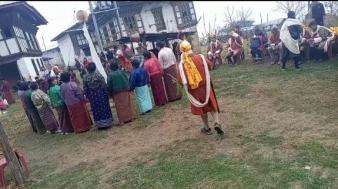 Tseza Bonkor: Bon Ritual of Tseza community
Tseza Bonkor: Bon Ritual of Tseza community
Tseza Bongkor is a native festival of Tseza Gewog (block) in Dagana with unique lyrics and dance steps performed by what we call in local dialect the Boegarps or the Pazaabs (Male participants/warriors). It is celebrated once in every three years in six villages under Tseza Gewog namely in Zamtog, Samey, Trashigang, Jangsagang, Tsanglaykha and Kalizingkha. In every village, the festival is celebrated for three days and it is mandatory for all the households of that particular village to take part in that celebration. At Samey, the festival is always celebrated on the 14th Day of the first Bhutanese month every three years at a place called Zingkha Pangna and only then, it is celebrated at Trashigang. It is because the festival at Trashigang is also presided over by the same Male Shaman (Pawo) and the Female Shaman (Neljorm) who conducts the festival at Samey. On the last day of the Samey Bonkor i.e. on 16th day of the first Bhutanese month, the Shaman and the Yogini heads towards Trashigang for the celebration of the same. The Trashigang Bonkor begins from 16th and ends on the 18th day of the first Bhutanese month. Although the festival is celebrated for three days in all the six villages but the date of celebration differs in all the villages. For instance the date for celebration of the festival is fixed at Samey and Trashigang but in the remaining four villages the dates are not fixed. They celebrates the festival depending upon the auspicious date that is mentioned in the Bhutanese Datho (Almanic calendar). Every household must dispatch at least one or two representatives (depending upon the number of person living in that house) for the celebration. Usually all the households are represented by two members i.e. one male representative who acts as a Boegarp (male dancer) and one female representative as a dancer. If the household has just one member, that particular person has to represent his or her household. If any household fails to send the member representative/s for the festival, they have to send their substitution or else they have to pay fine. Traditionally, the festival used to be presided over by a Male shaman (Pawo) and a Female shaman (Neljorm) but since the demise of the Pawo few years back, he is replaced by one of the village Lama. There are slight differences in the way the festival is celebrated in these six villages mainly in terms of the date of the celebration, materials and the costumes used in the celebration and the persons involved in the festival. The origin of the festival is still unknown but it is believed that the festival was instituted in the region mainly by the Tseza Nyagoes (Boegarps). According to Ap Sangay Dorji, the festival was instituted mainly to appease the Dralha (deities) in order to overcome any sort of obstacles and epidemics in the region. Tseza Bongkor is still vibrantly performed in the community and there is no major transformation in the way the festival is conducted even today. Traditionally every word written in the book Dralha Pangtoed (Ritual text) was dictated upon the Boegarps by the Pawo which is today replaced by the village Lam. Similarly, the house in which the shaman and the Female shaman live during the celebration Lha chim (shrine) was build using the mated bamboo but today it is constructed using the metal sheets, wood and bamboo. According to some oral history, traditionally the people of this region were following the Bon (locally called Ban choe) religion because of which their festival came to be known as Bangkor, the Bon festival of Tseza Gewog. Some oral tradition also says that during Zhabrung's era, The Pazaabs in Punakha performed their dances in circular (kora chap di) group to celebrate their victory over the Tibetan enemies. For the same reason, the Ngagoes (strong man) or the Boegarps of Tseza Gewog also performed the same dances following the same steps. Hence, the festival came to be known as Tseza Bangkor, the dance performed by Boegarps in a circular group. Tseza Gewog is one of the important Gewog under Dagana Dzongkhag (district) since Dagana falls under Tseza gewog and is where the Dzongkhag Administration's Headquarter is located. One of the most famous and special Temple in Dagana, Shathong Lhakhang, founded by the Buddhist Master Dupthob (Siddhi) Shawa Ripa in the 18th century is also located under Tseza Gewog. Shawa Ripa is an ancient Buddhist Master who is said to have lived for over 900 years. Oral History also mentions that there is a big tree at Pele, which is believed to be a walking stick of Zhabdrung Jigme Chogyal (1862-1904) and a house in which the Zhabdrung halt his night on the way and back from Daga Dzong.
#native
#festival
#lyrics
#dance
#steps
#local deities
#communities
Bhutan